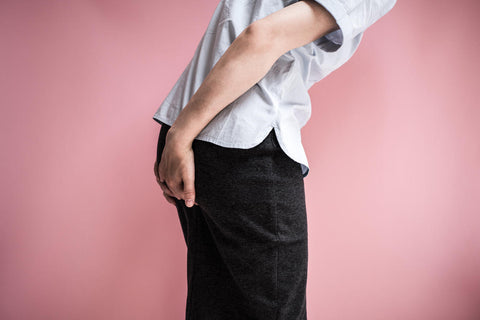HEMORRHOIDS

Hemorrhoids are dilated veins that form in the anus or rectum. It is normal for the veins in the anal area to swell slightly when you have a bowel movement. But unlike normal veins, hemorrhoids stay dilated all the time.
About 1 in 2 adults over the age of 50 have hemorrhoids. Constipation, pregnancy and loss of tissue tone with age are the main causes. In pregnant women, symptoms of hemorrhoids usually go away after childbirth.
Symptoms are occasional and easily recognizable: itching near the anus, discomfort when sitting, and bleeding when having a bowel movement. Usually, a hemorrhoid attack lasts a few days, then the symptoms subside.
Most people with hemorrhoids are able to relieve their symptoms with a variety of home treatments and, if needed, over-the-counter medications. However, hemorrhoids sometimes generate persistent pain or almost permanent discomfort. In these cases, medical treatment may be considered.
Hemorrhoids: external and internal
External hemorrhoids
They appear under the skin at the opening of the anus. They can cause swelling in the area. They are more sensitive than internal hemorrhoids because there are more sensitive nerve fibers in this area. In addition, the risk of a blood clot forming in an enlarged vein is greater than with internal hemorrhoids.
Internal hemorrhoids
They form in the anus or the lower part of the rectum. They form a small protuberance. They are classified according to their stage of development. They tend to progress from one degree to another if nothing is done to slow down their progress.
First degree. The hemorrhoid remains inside the anus.
Second degree. The hemorrhoid comes out of the anus when you have a bowel movement, and returns to its normal position when you stop exerting yourself.
Third degree. The hemorrhoid should be gently replaced with the fingers after defecation.
Fourth degree. The hemorrhoid cannot be placed back inside the anus.
Symptoms
Sensation of burning, itching or discomfort in the anal area.
Bleeding and slight pain when defecating.
Sensation that the inside of the rectum is swollen.
Weeping mucus from the anus.
Exit from the anus of tender protuberances (only in the case of internal hemorrhoids of the 2nd, 3rd or 4th degree).
People at risk
People with a close relative who has hemorrhoids.
Pregnant women.
Women who have given birth through vaginal birth.
People with cirrhosis of the liver.
Risk factors
Have constipation or diarrhea on a regular basis.
Suffer from obesity.
Remain seated on the toilet seat for a long time.
Being called upon to frequently lift heavy objects.
Perform anal intercourse.
Possible complications
When the discomfort or mild pain turns into severe pain, it is usually a sign that a blood clot has formed in a hemorrhoid. This is a painful but harmless hemorrhoidal thrombosis. Symptoms normally go away within 1 to 2 weeks, with pain relievers and emollient laxatives, which soften the stool. After the clot resorbs, a small, painless swelling in the anus, called a mariscus, may form (only with external hemorrhoids).
In rare cases, an ulceration (sore that tends to spread) may appear. Heavy blood loss can also cause anemia.
Treatments
Treatment for hemorrhoids begins with relieving symptoms. Here are a few tips :
Take a sitz bath for about 10 minutes several times a day with lukewarm water.
Apply a hemorrhoidal cream that has an anti-inflammatory effect to reduce your inflammation and swelling. You can also choose to insert a hemorrhoidal suppository.
Drinking clean chamomile tea might be helpful for some people.
Putting on cotton underwear can make you feel more comfortable.
Ice pack can help reduce swelling
Applying ice can help relieve the inflammation.
In order to prevent hemorrhoids from coming back, you will need to prevent constipation by increasing fiber and helping fluids in your diet. This means that you should eat a lot of fiber and drink six to eight glasses of fluid (not alcohol) per day. This will make your stools softer and easier to defecate, which will reduce the pressure on the hemorrhoids. This diet also helps prevent hemorrhoids from protruding.
Good sources of fiber include whole vegetables, fruits and grains. Also, you can try an emollient or fiber supplement like psyllium (Metamucil) or methylcellulose (Citrucel).
In a few isolated cases, hemorrhoids are treated surgically. The doctor will usually perform the procedure in their office or while in hospital. A number of methods can be used to eliminate or reduce the size of internal hemorrhoids. These techniques include:
Rubber band ligation: A rubber band is placed around the base of the hemorrhoid, passing through the inside of the rectum. The wide elastic bands reduce the blood supply to hemorrhoids. These dry out and fall off after a few days.
Sclerotherapy: A chemical is injected through the blood vessel to shrink the hemorrhoid.
Infrared coagulation: A special device is used to burn the hemorrhoidal tissue.
Hemorrhoidectomy: In some cases, internal or external hemorrhoids are so large or severe that they require surgery called a hemorrhoidectomy. But it is very rare.
However, be aware that these surgeries are not always guaranteed, as they have a multitude of side effects such as chronic anal fissures and increased bleeding.
Natural solution with Rectolus
Rectolus is an all-natural product that restores the entire rectal and anal system and corrects all symptoms related to internal and external hemorrhoids.
